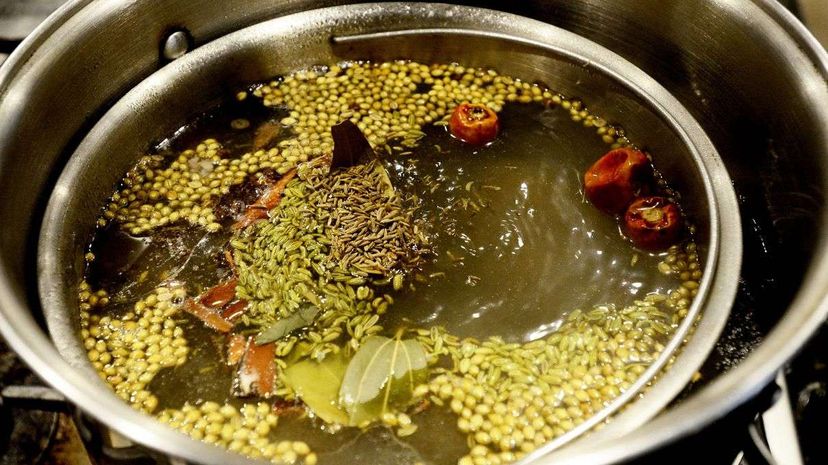
A savory stew of lobster shells, fish heads and vegetable scraps gently bubbles in the kitchen of Chef David Santos' Portuguese-influenced restaurant, Louro, in New York City's West Village, and, it's been simmering not for hours, but for months.
Born on Aug. 9, 2014, Stu, as the concoction is affectionately called by Santos' team, began with nothing more than the desire to address the problem of food waste and three ingredients: milk-fed pork stock, shellfish and kindai kanpachi (a Japanese fish). Today's more mature Stu feeds on various proteins, vegetables and other kitchen leftovers.
Advertisement
Santos is known to change Stu's flavor profile by altering its diet, and any of the seasonal foods served to his diners are fair game as stew ingredients. Smoked anchovies, grass-fed beef trimmings, lamb fat, shellfish carcasses and roasted chicken bones, as well as unused vegetables, herbs and mushroom stems all have been incorporated over the months.
But in case you're wondering about the mouthfeel of a mixture with these ingredients, unlike stews such as beef stew or burgoo, perpetual stew is skimmed and strained, leaving behind only dark, rich broth. Called "liquid Umami" by American chef Michael Colameco, it's more than a cup of bone broth: It's the flavorful base of intensely complex dishes such as duck ramen as well as garlic soup and a lobster chawanmushi, a Japanese custard steamed in a tea cup.
The practice of slowly developing a complexly flavored stew has a long history, and one of the most famous examples is bigos, a meat and sauerkraut dish dating back to 14th-century Poland. It's also known as hunter's stew, or a hunter's pot, simmering game meats and foraged ingredients (herbs, vegetables and fruits), wine, spices and traditionally, sauerkraut for at least a few days, minimum. New food scraps — leftovers and harvested foods — are often added as the stew develops.
While this stew requires extended cooking time (and the tricky logistics of keeping a simmer going even when you may be away), some recipes also encourage freezing some of the mixture, allowing it to further develop a spicy-sourness. That spicy-sourness is an important milestone in developing a perpetual stew: That's fermentation. Any food can be fermented, under the right conditions.
Sauerkraut and kimchi are common savory fermented foods — as are other preserved items such as pickled vegetables. The special thing about these foods is the live bacteria they contain. This is the so-called "good" bacteria that lives in your gut microbiome; it keeps "bad" bacteria from flourishing among your intestinal flora and supports your immune system.
There's a fine line between fermented and spoiled. Stu, for example, cooks over an induction burner, simmering at a temperature of about 200 degrees Fahrenheit (94 degrees Celsius). That's the temp when a bubble or two continue to pop on the broth's surface every few seconds. And those bubbles are good news for those grossed out by the idea of eating foods some might consider past their prime. Bacteria known to cause food-borne illness flourishes at temperatures between 40 degrees Fahrenheit (5 degrees Celsius) and 140 degrees Fahrenheit (60 degrees Celsius), but can't survive the heat of a constant simmer. Properly prepared and maintained, Stu could become part of the family, similar to sourdough mothers passed along through generations.
“The recipe for a stew made during a hunting party in Eastern Oregon has become part of our family history, despite initial skepticism about the quantity — and quality — of a stew made from daily leftovers of week-long trips, all cooked over a campfire” says Brynne Sapp in an interview. “They called it 'push,' and it's become a family tradition.”
Fermented foods, in addition to being flavorful and frugal, have been linked with certain health benefits. Research into different strains of Lactobacillus found in fermented dairy products such as kefir and yogurt finds an association between consuming these foods and a reduction in gastrointestinal (GI) problems such as diarrhea and irritable bowel syndrome (IBS). Eating fermented dairy containing live cultures, too, is associated with a reduced risk of developing allergies, Type 2 diabetes, and respiratory and cardiovascular diseases. L. salivarius specifically may help protect you against certain infectious diseases. Ongoing investigation continues into links between probiotic strains and the reduction of other diseases, including joint pain and stiffness, and skin conditions. Research is also underway regarding the anti-cancer benefits of some fermented foods; and, it turns out that Stu may have positive effects on mental health, too.
Advertisement